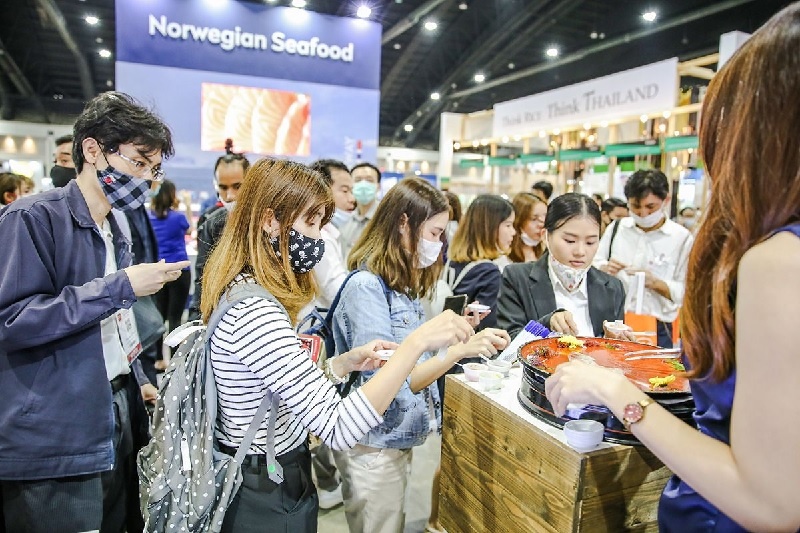World opening eyes to exciting Vietnamese offerings in F&B
 |
| World opening eyes to exciting Vietnamese offerings in F&B. Source: thaifex-anuga.com |
In order to contribute to the cooperation and trade exchange of businesses in Vietnam and Thailand, THAIFEX-Anuga Asia, the region’s largest food and beverage (F&B) trade fair, is taking place on May 24-28.
This year’s fair at the IMPACT complex in Bangkok will include 1,200 exhibitors, 2,500 high-profile buyers, 11 food segments, and approximately 40,000 visitors across the industry.
“Participating in the exhibition, we believe that the brands and quality of Vietnamese F&B products will be welcomed in this market. Moreover, Thailand could become a stronger link for Vietnamese goods to enter other markets in which major Thai retailers are reaching out,” said the representative of one Vietnamese business joining the exhibition.
Thailand is one of the most familiar and promising markets for exporting F&B products. At last month’s meeting between the industry and trade ministers of the two countries, discussions took place on extending the trade of fruit imported from Vietnam to Thailand, in addition to the licensed products of white and red dragon fruit, litchi, longan, and also mango.
“The Vietnamese side is currently interested in market access for products such as pomelo, passion fruit, custard apple, and rambutan, while Thailand would like to import rambutan, mango, poultry, and eggs,” said Nguyen Hong Dien, Vietnam’s Minister of Industry and Trade.
Trade exchanges between Thailand and Vietnam in 2021 reached $18.8 billion, up 17.9 per cent on-year. Some specific measures were provided by the two sides, including minimising the application and finding ways to remove unnecessary trade barriers to ensure the normal operation of supply chains; establishing an information exchange channel between agencies in charge of trade remedies; coordinating in organising trade promotion activities in Thailand and Vietnam; encouraging Thai retail groups to act as bridges bringing Vietnamese goods to Thai consumers; and also developing cooperation opportunities in the field of logistics to support and improve commercial performance.
Thailand is just one of several nations on the continent that are interested in new and exciting Vietnamese goods.
Coffee from Vietnam is being warmly welcomed in China as the demand for the beverage grows north of the border. Yu Cuong, deputy director of the Department of Commerce in China’s Sichuan province, explained that the pandemic has not reduced the demand for coffee. According to the China Coffee Association, coffee consumption there is growing at an average annual rate of 15 per cent.
In addition, earlier this month, a delegation of 60 Chinese enterprise representatives took part in an online conference with Vietnamese counterparts to look for coffee export partners.
Elsewhere, India is a promising land for both Vietnamese tea and coffee. Bui Trung Thuong, counsellor of the Vietnam Trade Office in India, Nepal and Bhutan, said that for the first time, bilateral trade between Vietnam and India exceeded $13 billion in 2021, an increase of 36.5 per cent on-year
Since the beginning of 2022, Vietnam’s export turnover to India has increased by 12.6 per cent on-year. Tea and coffee, especially instant coffee, are popular products in this massive market.
“Currently, the purchase of these products from Vietnam is being sought by many Indian businesses. Since the beginning of this year, hundreds of Indian enterprises have been looking for new partners for processing, local consumption, and export,” Thuong said.
Meanwhile, for long-term markets further afield, such as Europe, seafood is the favourite item. Nguyen Thi Thu Thuy, deputy director of the Ministry of Industry and Trade’s Export Promotion Center, said that since the EU-Vietnam Free Trade Agreement took effect in August 2020, around 220 tax lines of aquatic products have been set at 0-22 per cent of basic tax, while the remaining tax lines will be reduced to zero within 3-7 years.
“Thereby, Vietnamese seafood is increasing its price competitiveness compared to similar products of other countries,” said Thuy.
At present, the five largest seafood export markets of Vietnam in the EU are the Netherlands, Germany, Belgium, Italy, and France, making up 72 per cent of the total. Exports of all major products to the EU have also grown by double digits. Notably, the export of shellfish to the EU market increased sharply last year by 37 per cent, reaching $87 million.
Most surprising is that clams have become the fourth-largest seafood species in terms of export value to the EU market, with exports to the three largest markets of Spain, Italy, and Portugal all growing 38-44 per cent.
What the stars mean:
★ Poor ★ ★ Promising ★★★ Good ★★★★ Very good ★★★★★ Exceptional
 Tag:
Tag:
Related Contents
Latest News
More News
- Businesses ramp up production as year-end orders surge (December 30, 2025 | 10:05)
- Vietjet chairwoman awarded Labour Hero title (December 29, 2025 | 13:06)
- How to unlock ESG value through green innovation (December 29, 2025 | 10:03)
- AI reshapes media and advertising industry (December 29, 2025 | 08:33)
- FPT and GELEX sign deal to develop blockchain tech for global markets (December 29, 2025 | 08:29)
- Vietnam’s GDP forecast to grow by 9 per cent in 2026 (December 29, 2025 | 08:29)
- Women entrepreneurs are key to Vietnam’s economic growth (December 29, 2025 | 08:00)
- Vietnam's top 500 value-creating enterprises announced (December 27, 2025 | 08:00)
- The PAN Group shaping a better future with ESG strategy (December 26, 2025 | 09:00)
- Masan Consumer officially lists on HSX, marking the next phase of value creation (December 25, 2025 | 13:20)























 Mobile Version
Mobile Version